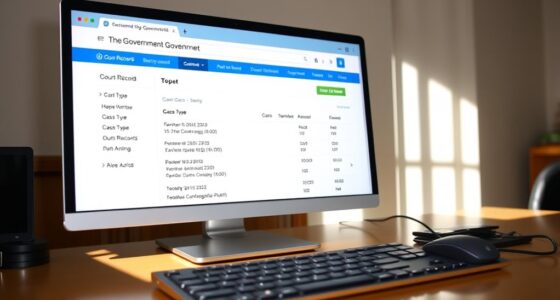To use court transcripts effectively in academic research, guarantee you handle ethical and legal considerations carefully by anonymizing sensitive information and obtaining necessary permissions. Focus on accurately representing the language, including legal jargon and courtroom exchanges, to avoid misinterpretation. Properly cite sources to maintain credibility and ensure reproducibility. By paying attention to these best practices, you’ll produce credible, insightful analyses that shed light on legal and social dynamics—exploring further will provide more detailed guidance.
Key Takeaways
- Ensure proper citation and referencing to maintain academic integrity and reproducibility.
- Obtain necessary ethics approval and anonymize sensitive information to protect privacy.
- Understand legal jargon and language nuances for accurate interpretation of courtroom exchanges.
- Focus on authentic analysis of legal and social dynamics, avoiding misrepresentation of transcripts.
- Uphold transparency, accuracy, and ethical standards to contribute credible insights in law and sociology research.

Using court transcripts in academic research can provide valuable insights into legal processes, societal issues, and human behavior. These transcripts serve as detailed records of courtroom proceedings, offering firsthand accounts of how justice is administered, how legal arguments are constructed, and how judges, lawyers, and witnesses communicate. When you incorporate court transcripts into your research, you’re equipped with primary sources that can deepen your understanding of legal interpretation. They reveal how laws are applied in real-world situations, exposing nuances and ambiguities that often escape statutory texts alone. This makes transcripts an essential tool for analyzing how legal professionals interpret statutes, precedents, and legal principles in the heat of courtroom debate. Proper citation and referencing of transcripts are also crucial to maintain academic integrity and reproducibility of your research.
However, utilizing court transcripts requires careful attention to ethical considerations. These documents often contain sensitive personal information, and it’s your responsibility to respect privacy and confidentiality. Always anonymize data where necessary and seek approval from relevant ethics boards if your research involves identifiable details. Maintaining ethical standards isn’t just about compliance; it ensures that your research upholds the integrity of the legal system and respects the dignity of those involved. Additionally, when citing transcripts, you should be precise about your sources, ensuring that your work accurately reflects the original proceedings without misrepresentation. Proper citation not only enhances the credibility of your research but also aligns with academic honesty standards.
Another key aspect to contemplate is the interpretation of language within transcripts. Courtroom dialogues are rich with legal jargon, colloquialisms, and context-dependent expressions. Your role is to analyze these transcripts critically, understanding how language shapes legal outcomes and societal perceptions. This involves recognizing the subtlety of courtroom exchanges and the influence of legal interpretation on case results. Ethical considerations extend here too; misrepresenting or oversimplifying these dialogues can distort the original meaning and impact your findings. Being aware of language nuances helps ensure that your interpretations remain accurate and insightful.
Incorporating court transcripts into your research is a powerful way to analyze legal and social dynamics authentically. Still, it demands rigorous attention to ethical considerations and a keen awareness of legal interpretation challenges. By carefully managing these aspects, you’ll produce research that is not only insightful but also respectful of the individuals and institutions involved. The transparency and accuracy you uphold will ultimately strengthen your work’s credibility and contribute meaningfully to academic discourse in law, sociology, or related fields.
Frequently Asked Questions
How Can I Ensure the Accuracy of Court Transcripts for Research?
To guarantee the accuracy of court transcripts for your research, start with robust verification methods like cross-checking transcripts against audio recordings or official court documents. Pay close attention to transcription accuracy by reviewing transcripts carefully and consulting with court reporters if needed. You can also use multiple sources to verify details. These steps help confirm the reliability of your data, making your research more credible and precise.
What Are Common Legal Terminologies I Should Understand?
You should familiarize yourself with common legal jargon and courtroom vocabulary to understand court transcripts better. Terms like “plaintiff,” “defendant,” “testimony,” and “objection” are essential. Knowing these words helps you follow the proceedings and interpret the context accurately. Make a glossary of key terms, and refer to legal dictionaries if needed. This knowledge guarantees you grasp the nuances of courtroom language, improving your research clarity.
Are There Ethical Considerations When Using Court Transcripts?
Imagine you’re studying a court case involving sensitive personal information. You need to take into account ethical issues like confidentiality concerns and informed consent. You must ensure that using court transcripts respects individuals’ privacy and that you have proper permission if required. Failing to do so could harm those involved and compromise your research integrity. Always evaluate these ethical considerations carefully to maintain trust and adhere to legal and moral standards.
How Do I Cite Court Transcripts Properly in Academic Work?
When citing court transcripts, you should follow proper citation formats and transcription standards. Typically, include the case name, case number, court, date, and page number if available. Use a consistent style like APA or Chicago, ensuring your citations are clear and precise. Make sure to specify that you’re referencing a transcript, and include details about the transcription source if applicable. Accurate citation helps maintain credibility and allows others to locate the original material easily.
Can Transcripts Be Used for Cross-Jurisdictional Legal Research?
While court transcripts can serve as valuable insights, traversing jurisdictional differences requires careful attention. You might find them useful for cross-border analysis, but keep in mind legal nuances vary widely. Using transcripts across jurisdictions can reveal patterns and contrasts, yet you should verify their authenticity and relevance. This approach enriches your research, helping you understand how legal processes differ or align across borders, ultimately strengthening your scholarly work.
Conclusion
By incorporating court transcripts into your research, you gain raw, authentic insights that textbooks can’t provide. While they’re detailed and sometimes complex, their value lies in the real stories they tell. Think of transcripts as both a puzzle and a window—challenging to navigate but offering a unique view into human behavior and legal processes. Embrace this resource, and you’ll uncover perspectives that textbooks simply can’t capture.









